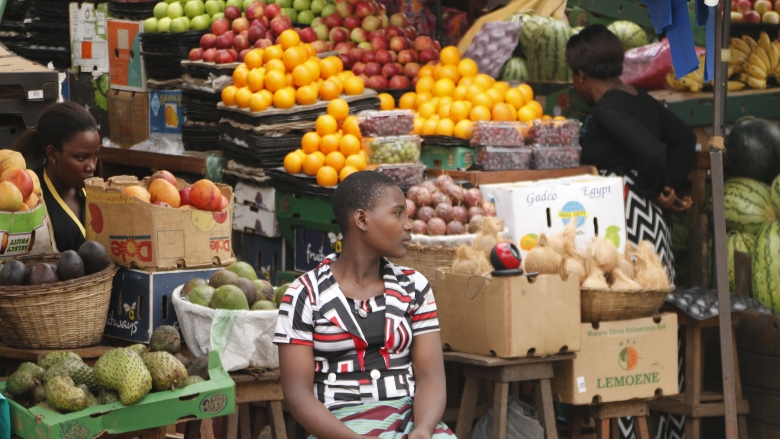KAMPALA, February 7, 2017 – The days of queuing up at the bank for a teller are numbered. More Ugandans are accessing cash at their convenience - at point of sale, and also via automated teller machines, the internet, and the mobile money services.
According to the World Bank’s most recent Uganda Economic Update, “Step by Step: Let’s Solve the Finance Puzzle to Accelerate Growth and Shared Prosperity,” financial services have expanded rapidly in Uganda over the past decade with approximately eight million adults now having access to an account at a formal financial institution.
“Access to financial services is an important step to achieving financial inclusion. Global experience shows that countries that have been able to achieve rapid, equitable economic growth have developed their financial systems to effectively mobilize savings and intermediate resources and channel these into productive activities,” said Rachel Kaggwa Sebudde, World Bank senior economist and lead author of the Update.
The formal financial system comprises commercial banks, credit institutions, microfinance depository institutions, community savings and credit cooperatives, insurance companies, and pension schemes. Others are securities exchange market, mortgage institutions and development banks. But according to the update, the rapidly growing popularity of mobile money is the highest contributor to access to financial services, particularly to the rural poor, women, and the informal micro, small and medium enterprises.
Rachel Nyapendi, who works as a housekeeper in Kampala, is among the seven million active users of the mobile money service. Every month, she saves her salary on her mobile phone account, and transfers some of it via cellphone to support family members back home in her village in Tororo, in Eastern Uganda.
“I don’t get much time off work to go and see my family. Mobile money makes it easy for me to send money to pay for medicine, food, school fees and other needs,” said the 36-year-old single mother of four.
Still, the report notes that a big percentage of the population remains unserved by credit due to high costs. Interest rates often range between 22 and 25% of the total value of the borrowed amount. Depending on the duration of the loan, consumers can end up paying more than twice the value of the original amount, which prevents many businesses and households from accessing bank loans. On the other hand, the low return on savings – 3 to 6 percent annually - and the high cost of credit have created a mismatch in the financial system which has constrained household and business spending.
While progress has been made, there is still no robust credit information system to enable lenders assess borrowers quickly and easily, the report notes. Uganda also lacks a collateral registry that would prevent borrowers from using the same collateral for multiple transactions. In an environment where information on borrowers is scarce and difficult to obtain (credit bureau coverage is 7%), lenders charge high interest rates to insure against the high risks. In contrast, 25.8 percent of adults are covered by the credit reference bureau in Kenya, implying lenders have a higher chance to check applicants for loans. In addition, there are few financial professionals in Uganda, and staff costs are high for banks – all of which contribute to high interest rates for loans.
Proximity to services also remains a key hindrance to the population, according to the report. Consumers have to travel over long distances to access formal financial institutions, many of them located in urban areas. Another constraint is the difficulty of the rural poor, women and the informal sector to meet the stringent documentation requirements.
The majority of the unbanked rely on personal savings, the report says, or borrow from informal unregulated intermediaries including “loan sharks”. A big proportion of the population keeps their savings in form of cash stored at home, or in livestock, gold, or other similar assets – all of which expose the owner to high risk.
The report notes that greater access and deepening of financial services could help reduce poverty and vulnerability by enabling Ugandan, including the rural poor, to diversify their sources of livelihood, reduce hunger, and increase their resilience from shocks and failing back into poverty. Easier access to financing is also crucial to expanding agricultural production through investing in better technology and agri-input, in order to raise rural incomes, generate jobs and raise productivity across the economy, the report says.
The Government has put policies and strategies in place to leverage the financial system to support economic growth. The National Financial Inclusion Strategy has paved way for agent banking, which will allow financial institutions to contract retail outlets to process financial services. The introduction of Islamic banking, bancassurance, and an increase of commercial bank capital threshold are further important innovations, the report says, while the creation of an independent Deposit Protection Fund will offer greater protection to consumers.
“Strong intermediation structures will build confidence in the financial system, encourage savers, ease access to credit for borrowers and lower the costs of credit, which in turn reduces the overall transaction costs for enterprises, making them more competitive,” said Valeriya Goffe, World Bank senior financial sector specialist and co-author of the report.
The report recommends that these measures are combined with efforts to improve the business environment, promoting financial literacy, introducing valid identification documents, encouraging land registration and titling, and strengthening consumer protection measures.

